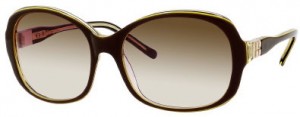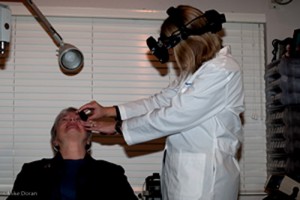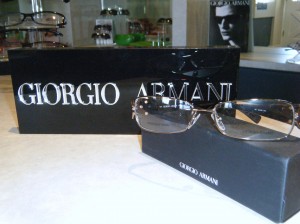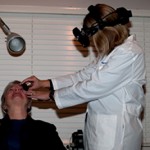This Saturday Westside Optometry is hosting a special designer eyewear event. Stop by the office between 10 and 2. There will be refreshments and a drawing for free lenses. Come by to try on frames from Max Mara, Liz Claiborne, Georgio Armani, Gucci and Saks Fith Avenue. This is an opportunity to see frames we do not ordinarily have available, and also to see all the colors and sizes of many different frames.
Author: admin
3-D Movies

Not everyone enjoys 3-D movies. Some viewers do not see the three dimensional effect and others may experience headaches, blurred vision and dizziness. These symptoms are common side effects for a person with binocular vision difficulties.
The 3-D effect is created by placing one image on one eye and another image is placed on the other eye. The polarized glasses are required to keep the images separate. People with binocular vision problems will not perceive the illusion of 3-D, and some will experience a “visual hangover.”
Several different visual problems could be the cause of the problem:
• Amblyopia or lazy eye. This occurs when one eye does not see as well as the other.
• Strabismus or crossed eyes. One eye does not line up in the same direction of the other eye.
• Convergence Insufficiency. The eyes are unable to turn inward simultaneously to fix a target at the same distance.
Some of the above problems can be corrected with glasses or contact lenses, patch therapy and vision training.
Dilation
A comprehensive eye examination includes pupil dilation. Using eye drops, the pupil is temporarily and painlessly enlarged to increase the view into the eye. This gives me the opportunity to thoroughly examine the structures inside the eye: optic nerve, blood vessels, macula and retina. With the pupil dilated, I can get a 3-dimensional view and better evaluate the eye for changes or the potential for problems. The effect lasts up to 4 hours and will reduce the ability to focus on near objects. It will be helpful to bring sunglasses and make arrangements accordingly.
Vision Test Should be the First Exam Students take this Year
To give your child a head start to a successful school year, educate yourself on the relationship of healthy eyesight and classroom performance.
Since 80% of a child’s learning is visual, a child’s ability to clearly see the blackboard and words on the page is critical. Many children do not know they have a problem because they think how they see is how everyone else sees. Unfortunately, some students who are labeled as having a learning disability or behavioral problems may simply have a vision impairment.
One in four school-age children have some form of vision problem. A child should not need to start failing in school before we realize there is a problem. Put “eye examination” on your back to school list.
Gas Station Sunglasses

Why spend more than $10 on sunglasses?
“Cheap sunglasses” are made with “cheap” materials. The poor quality lenses lack ultraviolet (uv) protection and create visual distortion. A pair of sunglasses should be safe, comfortable and provide clear vision. Features to look for in a pair of sunglasses include the following:
- Impact Resistance
A lightweight tough lens is ideal for sports and long hours of wear.
- Photochromic Options
Variable light conditions require different density of color. A photochromic lens adjusts color depending on the light condition. A lighter tint is required at dawn, dusk or overcast conditions while a dark colored lens is most comfortable midday and under bright condition.
- Special Tints
Color selection can enhance the visual experience and comfort. A solid tint has the same color intensity throughout the lens. A gradient tint is lighter at the bottom of the lens. This is useful if you are reading with the sunglasses.
- Polarization
This is a premium sunglass product that eliminates unwanted glare. Polarized lenses are especially appreciated on the water, snow, sand and pavement.
- Lens Treatment
A backside anti-reflective coating eliminates surface reflections and provides clearer vision
- Frame Styling
A wrapped frame will increase protection from the sun. Newer lens designs allow many prescriptions to be made for the wrap frame style.
Caring for your Glasses
You have carefully selected the best lens materials and designs to fit in a stylish frame, it is important to take good care of your new eyewear.
- Remove glasses from your face with two hands.

- Never place glasses lens side down, it is best to put them in their case when not wearing them.
- Clean glasses with water and a little oil-free soap. Wipe them with a clean cloth or a cloth especially designed for your lenses.
- Do not leave glasses on the dashboard of your car. (It gets too hot for the frame and any coatings you may have on the lenses).
- If your glasses start to slide or feel lopsided on your face, come by the office for an adjustment.
Computer Vision
Computer Vision
Computer technology has evolved faster than the human eyeball. Our eyes accommodate our reading needs by focusing downward and approximately 16 inches away. Most computer monitors sit about 18 to 24 inches away from our eyes and only a few degrees below eye level. This is not much of a problem if your visual system is working accurately, but if you have a little refractive error such as astigmatism, farsightedness, or a difference between the two eyes, the result may be headaches, eyestrain and frustration.
If you are 40 years of age or older, the stress of viewing a computer screen is probably compounded by presbyopia: your eyes no longer accommodate, or focus, to read. (You may have noticed that your arms seem shorter.) Bifocals are often prescribed between the ages of 40 and 50, to allow you to see a distant object and also focus downward and close-up.
For someone who spends more than a couple of hours a day in front of a computer screen, a pair of glasses designed specifically for that task is the best solution. Do you wear cleats for golf? Flip-flops at the beach? Old tennis shoes to wash the dog? Do you have special shoes for special events? One pair of shoes can not fill every need; a single pair of glasses does not either.
A lens designed especially for the computer is recommended. It may be a single vision lens or a specifically designed multifocal.
A few more tips for comfortable computer use:
• Modify the room lighting to reduce glare and reflections.
• Anti-glare coatings can also eliminate reflections from windows, overhead lights and other computer monitors
• Place reference materials close to the screen so you do not have to turn your head back and forth to read.
• Use high-index materials to keep lenses thinner and lighter in weight.
• Take breaks to rest your eyes.
Visual Field Testing
Visual Field Testing
A perimeter is used to test your visual field. Your visual field includes both your central and side vision. During this test, while you are seated comfortably, you will be asked to look straight ahead at a central fixation target. You will be instructed to press a button when you become aware of a small shimmering light anywhere within your peripheral field. It’s important that you keep your eyes focused on the central target throughout this examination so that an accurate reading of your visual field is obtained.
This test can detect vision loss, even if the loss is far to the side or quite subtle. Even a large and profound vision loss in one eye’s visual field can go unnoticed by a patient because the visual field of the opposite eye overlaps it to a great extent. One eye simply “fill in” the area of vision loss present in the opposite eye. This is why the side-vision test is always administered to each eye separately.
The nerve pathways from the retina to the part of the brain where vision is interpreted are very uniform from person to person. Because of this uniformity, visual field analysis has a great deal of diagnostic value. Glaucomatous visual field loss usually follows a particular pattern. Other diagnostic patterns of visual field loss can indicate retinal detachment and neurological diseases, adding significantly to the value of this test. The nerve pathways for vision are long and cross over many brain structures on their route from the eye to the very back of the brain (visual cortex). Neurologists make great use of visual fields to help them determine where in the brain a tumor or other pathology is located.
Family History and Glaucoma
Family History and Glaucoma
 According to a study reported at the World Glaucoma Congress, the most efficient way to detect Primary Open-Angle Glaucoma (POAG), which is the most common form of glaucoma, is by knowing the medical history of close relatives with the disease. If you have a parent, sibling or child with POAG you have a greater than 25% chance of developing the disease. Others at risk include African Americans over 40, and anyone over 60, especially Mexican Americans. The earlier POAG is detected, the better the prognosis for retaining vision throughout one’s life. POAG occurs when the fluid that nourishes the eye cannot drain properly and the resulting increased pressure inside the eye damages the optic nerve. This is painless and not visually noticeable at first, but will lead to vision loss and blindness if left untreated. Increased pressure in the eye isn’t a sure sign of POAG, but it is a sign of increased risk for the disease.
According to a study reported at the World Glaucoma Congress, the most efficient way to detect Primary Open-Angle Glaucoma (POAG), which is the most common form of glaucoma, is by knowing the medical history of close relatives with the disease. If you have a parent, sibling or child with POAG you have a greater than 25% chance of developing the disease. Others at risk include African Americans over 40, and anyone over 60, especially Mexican Americans. The earlier POAG is detected, the better the prognosis for retaining vision throughout one’s life. POAG occurs when the fluid that nourishes the eye cannot drain properly and the resulting increased pressure inside the eye damages the optic nerve. This is painless and not visually noticeable at first, but will lead to vision loss and blindness if left untreated. Increased pressure in the eye isn’t a sure sign of POAG, but it is a sign of increased risk for the disease.
Early diagnosis is of utmost importance. Dr. Griffith examines different parts of your eye to determine if you have or are at risk for developing POAG. Detection and diagnosis relies on tests for pressure within the eye (Tonometry), corneal thickness (Pachymetry) and observation of the optic nerve (Ophthalmoscopy) and visual fields, including peripheral vision. Because of the increased risk among family members, a review of family history is also part of the screening. (Likewise, a positive diagnosis of POAG would be valuable information for close family members.)
Vision lost to glaucoma cannot be restored. The goal with treatment is to slow the disease progress and prevent further vision loss. The most common treatment is a prescription eye drop or pill meant to reduce pressure in the eye. It is important for Dr. Griffith to be aware of other medications you are taking in order to fi nd a compatible treatment for the glaucoma; fortunately there are usually several options. Additional treatment includes laser surgery or sometimes more traditional surgery; both physically alter and improve the drainage structure in the eye. In conclusion, regular eye examinations are a certain age is vital to prevent unnecessary vision loss. If you are newly diagnosed with POAG or any form of glaucoma, Dr. Griffi th can give you much more detailed information.


